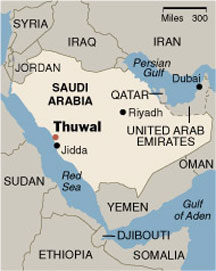Along the coast of the Red Sea, pockets of green
Dennis Whigham and Candy Feller, ecologists at the Smithsonian’s Environmental Research Center, both noticed the mangroves’ odd shape immediately. “They almost looked like bonsais,” Whigham recalls. The shrubs had mature trunks, but the branches and shoots were all new. To their trained eyes, the trees appeared to be recovering from severe damage such as that caused by a hurricane. But these mangroves had survived a different kind of damage: camel grazing.
You might not expect to find mangroves—trees and shrubs that grow in salty coastal habitats in the tropics—in arid Saudi Arabia, but along the country’s Red Sea coast there are pockets of green dominated by mangroves. Feller and Whigham searched out these mangroves during a November 2009 visit to Saudi Arabia. They are part of a team of ecologists that is partnering with the staff of the new King Abdullah University of Science and Technology in Thuwal, Saudi Arabia.
KAUST opened its doors to students this past fall and is positioning itself as a leader in environmental sustainability—both in research and practice. Feller and Whigham are members of a consortium of scientists, funded by KAUST, that is focused on issues related to soil, water and coastal ecosystems. Among other projects, the group is helping the university incorporate mangroves into its wastewater treatment plans. The scientists are also investigating the basic ecology of the Red Sea’s mangroves.
Whigham likes to look for different “expressions” of mangroves. He studies the relationship between the structure of mangroves and processes such as nutrient cycling and growth. The most distinctive mangroves he encountered on this trip were on the Farsan Islands, located off the southeast coast of Saudi Arabia. Pelicans roosted in the treetops, but Whigham was more impressed by the red and black mangroves that were rooted in cracks of the coral substrate. Their habitat was very different from the swampier looking mangroves he and Feller have studied in other places.
 At 22 degrees north, Thuwal is close to the northern edge of mangrove habitat. This fact alone made the area an important destination for Candy Feller. Feller has developed an international network of mangrove research plots that includes sites in North and Central America, Australia and New Zealand. She is investigating how nutrients limit the growth of mangroves and subsequently influence the food web. To explore these questions on a global scale, she needs a range of plots north and south of the equator to study.
At 22 degrees north, Thuwal is close to the northern edge of mangrove habitat. This fact alone made the area an important destination for Candy Feller. Feller has developed an international network of mangrove research plots that includes sites in North and Central America, Australia and New Zealand. She is investigating how nutrients limit the growth of mangroves and subsequently influence the food web. To explore these questions on a global scale, she needs a range of plots north and south of the equator to study.
Feller and Whigham added two new sites to Feller’s global mangrove network on this trip. The heart of Feller’s experiments involves tagging branches and monitoring their response to nitrogen or phosphorus fertilizer. Because the trees require fertilizer every six months, she will rely on local KAUST scientists for help. Feller and Whigham trained two scientists on the use of their fertilization techniques. These KAUST researchers will also use the new study sites to explore their own questions.
Collaboration is at the heart of international expeditions like this one. Many of the ecologists in the group have been working together on a separate mangrove project in Florida. That work was funded by a grant from the Smithsonian’s Marine Science Network . Whigham and Feller credit the MSN grant with fostering the relationships from which the KAUST research project grew.
Feller and Whigham plan to continue their work in Saudi Arabia for years to come. Feller expects to get five years of data from her new mangrove plots. Whigham is optimistic that the team of ecologists will help protect the Red Sea from pollution by excess nutrients by including mangroves in KAUST’s wastewater treatment plans.
To find out more about the team of ecologists working with KAUST on water, soil and coastal resources visit: http://www.sowacor.nl/. Click below to view a slide show of highlights from Whigham and Feller’s research trip.
Posted: 29 December 2009
-
Categories:
Environmental Research Center , Feature Stories , Science and Nature




